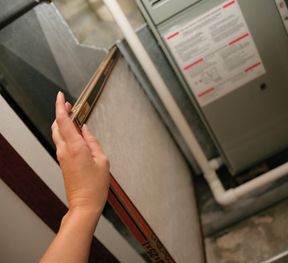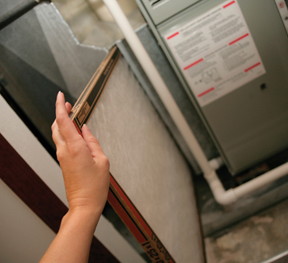Change is Good

 Today’s high-efficiency heating and cooling systems require very little attention and maintenance from homeowners. They do a great job of keeping us comfortably cool in summer and toasty warm in winter with very little effort from us. However, other than scheduling regular maintenance visits, there is one task that falls on the homeowner: changing those air filters on a regular basis.
Today’s high-efficiency heating and cooling systems require very little attention and maintenance from homeowners. They do a great job of keeping us comfortably cool in summer and toasty warm in winter with very little effort from us. However, other than scheduling regular maintenance visits, there is one task that falls on the homeowner: changing those air filters on a regular basis.
There are usually two camps on this one: those who note the date they installed them and change them regularly, and those for whom the phrase “out of sight, out of mind” rings true. If you’re in that second camp, or somewhere in between, consider giving some thought to your air filters to help keep your heating and cooling system in top working order all year long.
Changing your filters is one of the easiest but most important maintenance tasks you can do in your home. These filters, which fit into the space directly behind “return” air grills, are designed to reduce the accumulation of dust and particles drawn into your air conditioning and heating system. By doing so, they protect the heating and cooling coils as well as other internal components of
your system, so it’s important to keep filters clean.
What size filter do I need?
The correct replacement size is generally printed on the old filter. If you cannot locate the size or are still unsure, simply open the return grill and measure the length and width of the filter you are replacing. It’s helpful to make note of the sizes you need (you may have different sizes in different locations of your home), and write these measurements down to keep in your wallet. This way, you’ll always have that information handy, and are more likely to purchase the filters in a timely manner and stay on top of this maintenance task. There’s nothing more frustrating than standing in front of the air filter display at the hardware store and second-guessing what size(s) you need at home.
 How often should I change the filter?
How often should I change the filter?
Experts suggest that how often you change the filter truly varies from house to house. Factors to consider are the home environment, the presence of pets, and whether any occupants have allergies. Be sure to check your filters regularly for excessive build-up of dust, dirt, fibers and more, and replace as necessary.
What is the benefit of purchasing a more costly filter as compared to a less expensive one?
Filter prices vary widely, adding to consumers’ confusion. Know this much: A regular, general-use filter provides only basic protection. It will capture the largest particles of dust and is the most inexpensive option. You should consider replacing this type of filter every 30 days. For better protection and cleaner air in your home, experts at the American Society of Heating, Refrigeration, and Air Conditioning Engineers recommend that you upgrade to a better filter. There are many types from which to choose, and prices range from $5 to $20 and more. Each step up in quality represents a higher, more efficient level of filtration.
How do I decide which filter is best for me?
Not sure what you should be spending on air filters? Consider a few things. First, determine the level and type of possible air contaminants in your home. Then read the packaging to determine which filter will eliminate those contaminants. Also, take into consideration whether you or anyone in your home suffers from allergies, asthma, hay fever or other breathing difficulties.
The basic, throw-away filter captures large dust particles. An upgraded filter captures dust particles, mold spores and pollen. The next level upgrade filter captures all of the above as well as smoke, pet dander and smog particles. An “advanced allergen” filter captures everything listed above plus dust mites. Once you have determined which filter suits the needs of your home and family, a quick trip to your local home center or hardware store should offer a varied selection of filters. Some department stores also carry a select line of filters.
What do the filter ratings mean?
Air filters are rated based upon their Minimum Efficiency Reporting Value, or MERV. MERV represents the filtering efficiency of a particular filter; higher MERV numbers represent better filters.
 Do I have options other than disposable filters?
Do I have options other than disposable filters?
Some manufacturers make a filter which is designed to last up to twelve months. It has a high MERV rating (12–14), and is wider, thicker and larger than the normal 1-inch household filter. Your system may require some modification in order to use this particular filter. Talk to your heating and cooling system professionals about this option.
Electrostatic filters may also replace disposable filters. These filters are washable and considered “permanent”. Other advantages of this filter are its nonrusting aluminum frame and lifetime warranty. It attracts dust particles and other contaminants by using an electronically charged field on metal plates. Again, your heating and cooling system professionals can tell you more about this type of filter.
Choosing an air filter may not be one of the most glamorous or exciting decisions you have to make, but it can be one of the most important ones when it comes to protecting your home’s heating and cooling system. Put your family’s health and safety first and avoid unnecessary repair costs later by making the right choice now—and changing your filter if you haven’t lately. n






